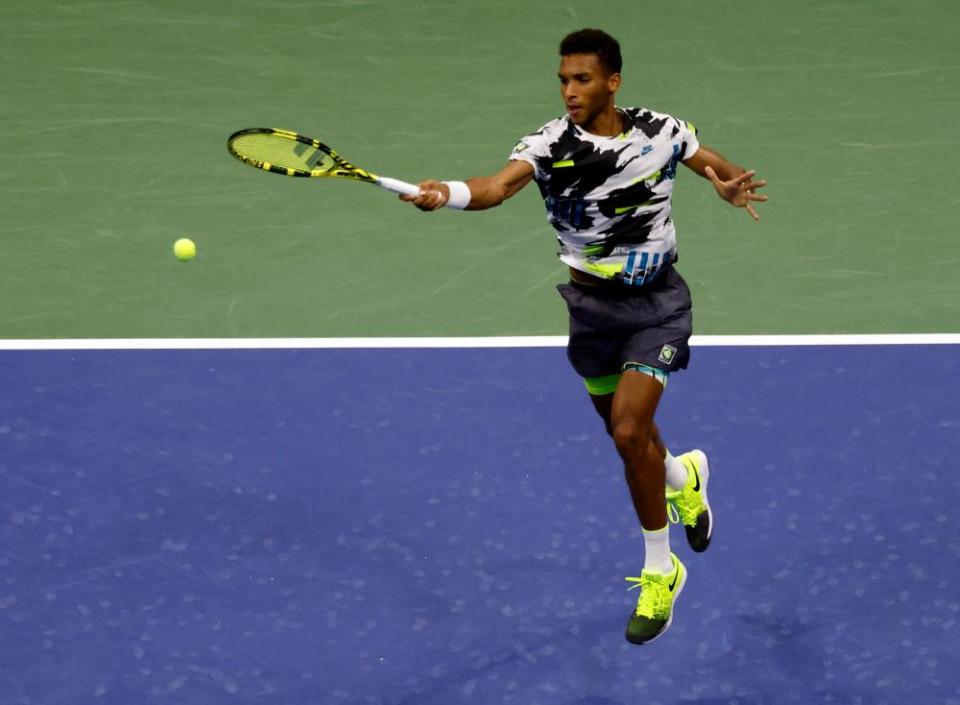Andy Murray still dreaming big despite heavy defeat at US Open
Andy Murray knows he is in the autumn of his playing years, but losing heavily against Félix Auger-Aliassime in the US Open on Thursday night – his first straight-sets defeat in the first week of a grand slam tournament in 14 years – has encouraged him to carry on rather than dwell on bitter disappointment.
“I don’t want to lose in straight sets anywhere,” Murray said, “and certainly not in grand slams. What I need to do is look at what happened the last couple of weeks, look at the things in my game that weren’t as I would have liked, and then look at what I can do to improve physically so that, if I’m in that situation again in a few weeks’ time in the French Open, I deal with it better.”
Murray said he still dreams of winning another slam. “It was hard enough when I had two normal hips, so it will be difficult. But I’ll keep trying – why not? Why shouldn’t I try my hardest to do that? And if I don’t, that’s all right. But I might as well shoot for the stars.”
Related: Flawless Felix Auger-Aliassime ends Andy Murray's comeback at US Open
There are respected observers – among them, Greg Rusedski and Murray’s friend Tim Henman – who doubt the 33-year-old Scot will win another grand slam title. Murray said in conversation with the Guardian recently that he was neither an optimist nor a pessimist in that regard, but a realist.
“I want to be given what the reality of the situation is, not someone trying to put a positive spin on it – or a negative spin. In life, sometimes things are shit and sometimes things are really good. But things aren’t really good all of the time.”
There was no denying the reality of Auger-Aliassime’s superiority in the two hours and eight minutes it took the Canadian to win 6-2, 6-3, 6-4 in front of a smattering of their peers and accredited officials in the otherwise empty Arthur Ashe stadium.
That is where Murray beat Novak Djokovic on an unbearably emotional night eight years ago to win the first of his three majors. It was also where Auger-Aliassime – who had won only three grand slam matches in his short career – first saw Murray play in 2012 when he beat Feliciano López in the third round.
After his own debut on the biggest court in tennis, Auger-Aliassime said: “Everything came together. It was very complete from the beginning to the end. I could see in Andy’s emotions he felt that it wasn’t his greatest night. I still understood why he was a great champion, with the way he was able to make you earn every point.”
All of which goes into the Murray computer, stripped of sentiment. In the aftermath, he acknowledged that Auger-Aliassime “got quite a lot of free points with the first serve and then, even when I was getting a racket on it, he was able to dictate off the first shot of the rally”.
There is not a player on the Tour who could have done much about Auger-Aliassime’s sustained power and precision, except perhaps Djokovic. He struck 24 aces among 52 clean winners and did not give Murray a look on his serve. Murray replied with eight winners in three sets and he surely sensed echoes of his own youth as he looked across the net.

Auger-Aliassime – who plays piano and would be an artist were he not so good at tennis – was the boys’ champion at Flushing Meadows four years ago. Murray’s long-ago straight-sets grand slam defeat – against the world No 51 Juan Ignacio Chela in the first round of the 2006 Australian Open – arrived two years after he had won the same boys’ title, which played a significant part in shaping the rest of his career.
Related: Serena Williams overcomes serving wobbles to set up Sloane Stephens showdown
Losing against Chela convinced Murray he needed to bulk up and he embarked on a physical training programme that made him one of the fittest in the sport; but even that shield could not prevent the string of injuries that have blighted his later years.
For a father of three, a knight of the realm and a widely admired sporting hero who has been away from elite tennis for 10 months and last played in a grand slam in January 2019, shortly before hip surgery that saved his career, Murray did “all right” against an opponent in full flight. However, all right has never been good enough for the former world No 1. Will it suffice now?
“I’ll need to build up over the next few months,” he said, “and hopefully, at the beginning of next year, if I can stay healthy, I will be better able to back up difficult physical efforts.
“I would like to play consistently better tennis, consistently higher-level tennis. I feel like I’m back at square one. But, even after tonight, I’m more positive about what I could do in grand slams than I was before I came over here.”
That was as clear as a bell: Murray loves tennis as much as he did when Chela was giving him a lesson in Melbourne 14 years ago. It is some drug.

 Yahoo Sport
Yahoo Sport 





































